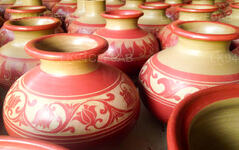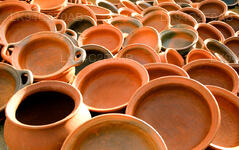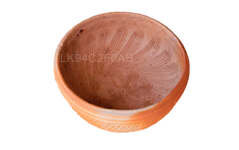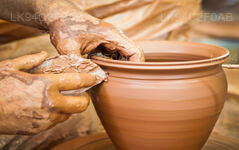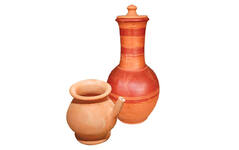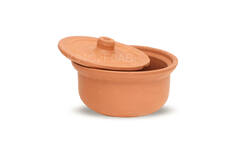Hatti Mutti
Hatti and Mutti are the earthen cookware used for cooking curry and Rice. Prior to the commencement of cooking, earthen cookware should be well heated until turned black. Mostly, the leftover grined coconut is put in earthen cookware and burnt till they turn black. Once a cookware is turned fully black with soot all over, it is washed and taken for cooking. Although cooking in earthen cookware takes comparatively long time, food does not react with the clay surface to produce toxic matter.
Pottery Culture Of Sri Lanka
In the beginning, Sri Lanka’s pottery culture observed a few simple guidelines: the utensil should first and foremost suit the function it is supposed to perform; it should always bespeak the suppleness, authenticity and the faultlessness of the clay used in its formation; the designs on the utensil should not interfere with the functionality and instead support the functionality if possible and the external beauty of the utensil, though important, should not be the priority. These sum up the culture of pottery in Sri Lanka and each type of earthenware seems to embody the guidelines.
Kalaya
The spherical form and the fluid curves of the ‘Kalaya’ resonate the symbols usually associated with those who use it most – women. The ‘Kalaya’ is used to carry and store water. Women would tuck the ‘Kalaya’ on their hips, put a protective arm around it and carry the water back home. Such everyday vessels though delicately curved have no designs on them whereas the ones used to perform the ‘Kala Gedi Natuma’ – a dance performed by women on 'Perahera', have dainty patterns on them.
Nambiliya
The ‘Nambiliya’ is an excellent example of the design supporting the functionality of the utensil. An even pattern of twisted lines or swirls spread deep into the curved bowl-like ‘Nambiliya’, and the patterns themselves serve the main purpose of the utensil. These utensils are used to clean rice after soaking and washing the rice several times in the ‘Nambilya’.
Muttiya
These pots which bear close resemblance to the ‘Kalaya’ sans the graceful curves, with slightly wider mouths, come in various sizes and perform a multitude of tasks. The regular sized pots are used to cook rice while the marginally larger pots are used to collect the juice of coconut and kithul flowers or to concoct a herbal mix which people use at the auspicious bathing time during the traditional New Year season.
Hattiya
Lengthwise, the ‘Hattiya’ is wide yet not as deep as the ‘Kalaya’ or the ‘Muttiya’. This shape renders these utensils ideal for cooking various curries and making certain sweetmeats. Some ‘Hatti’ come in handy with a lid to allow the curries to simmer in a dense cloud of heat.
Guruleththuwa and Kothalaya
Both items are used to store drinking water but each item has a distinctly unique shape. The ‘Guruleththuwa’ has a wide, rounded bottom and a long elegant neck that ends in a smoothly cut mouth. Certain ‘Guruleththu’ are adorned with patterns of dancers, flowers and vines. The ‘Kothalaya’ somewhat resembles a tea pot with a spout and is usually used in ‘Thovil’ ceremonies to store the sanctified water.

